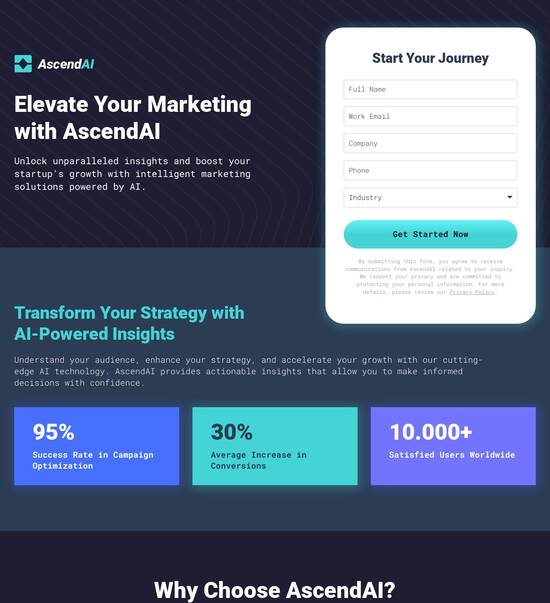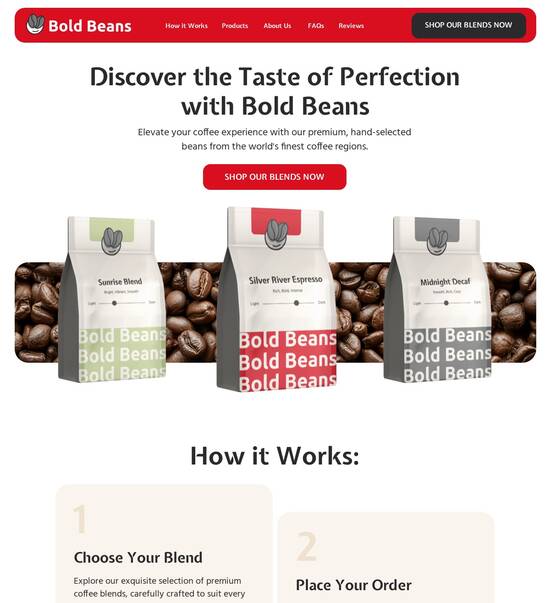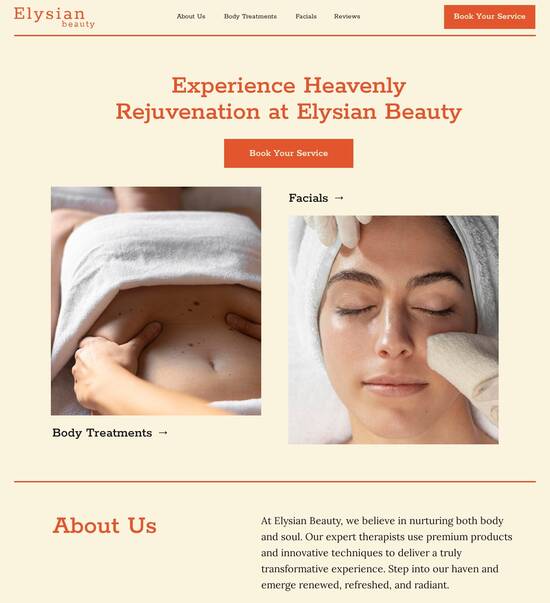
HTML page template for wastewater treatment plants
Use TemplateAbout template
Engage your audience like never before with stunning landing page templates for wastewater treatment plants. Make your online presence unforgettable!
Recommended templates

Easy to build without coding
With the intuitive drag-and-drop builder, anyone on your team can create high-converting pages without any knowledge of code or design. Make enhancements to your landing page with custom widgets using Javascript, HTML/CSS, or third-party scripts.

Multiple layouts for any industry and goal
Select from 500+ landing page layouts built to boost conversions across industry-specific scenarios. Customize them by adjusting fonts, adding images, and generating on-brand content with the AI assistant. Quickly scale with Instablocks® and Global Blocks that you can save, reuse, and update globally.

Loads fast and looks polished on any device
Every template is responsive, which means they present professionally on any device and load blazingly fast with our Thor Render Engine. You can also power them up with Google AMP technology to deliver an unparalleled mobile experience and drive higher conversions.

Robust analytics & experimentation
Get real-time updates and reporting across all your devices, showing the number of visitors, conversions, cost-per-visitor, and cost-per-lead. Launch AI-powered experiments, run A/B tests, and use heatmaps to analyze user behavior, then optimize your landing page to maximize conversions.







Easy to build without coding
With the intuitive drag-and-drop builder, anyone on your team can create high-converting pages without any knowledge of code or design. Make enhancements to your landing page with custom widgets using Javascript, HTML/CSS, or third-party scripts.
Multiple layouts for any industry and goal
Select from 500+ landing page layouts built to boost conversions across industry-specific scenarios. Customize them by adjusting fonts, adding images, and generating on-brand content with the AI assistant. Quickly scale with Instablocks® and Global Blocks that you can save, reuse, and update globally.
Loads fast and looks polished on any device
Every template is responsive, which means they present professionally on any device and load blazingly fast with our Thor Render Engine.
Robust analytics & experimentation
Get real-time updates and reporting across all your devices, showing the number of visitors, conversions, cost-per-visitor, and cost-per-lead. Launch AI-powered experiments, run A/B tests, and use heatmaps to analyze user behavior, then optimize your landing page to maximize conversions.
All the features you need to build lead-generating landing pages
Explore more featuresLearn how to build top-performing landing pages for any goal
FAQs
Leading the way in building high-performing landing pages





Maximize Your ROI with Instapage: The Ultimate Guide to Landing Page Optimization
Instapage presents a comprehensive roadmap for marketers aiming to enhance digital campaign performance. With its robust landing page and conversion rate optimization (CRO) capabilities, users can easily create high-converting pages that dovetail perfectly with their marketing strategies across various verticals.
Understanding the Power of Instapage
Instapage is designed to cater to a multitude of industries, including business services, education, and financial services. Its powerful features enable marketers to accelerate sales funnels, leading to improved return on investment (ROI). Understanding the importance of targeted landing pages is crucial for capturing leads effectively.
- High-converting templates: Gain access to over 100 customizable templates designed specifically to maximize conversions.
- Intuitive page builders: Create landing pages quickly without needing technical knowledge, facilitating a more streamlined production process.
- A/B testing capabilities: Optimize performance by conducting tests that allow for data-driven decisions on page elements.
Step 1: Choose the Right Template
Selecting the appropriate template is foundational for effective conversion. With Instapage's extensive library, you can leverage industry-specific designs that resonate with your target audience. Here’s how to make the best choice:
- Identify your target persona: Understand the audience you aim to attract and select a template that matches their preferences.
- Ensure mobile responsiveness: Opt for templates that provide seamless experiences across devices to capture mobile leads.
- Customize with your brand: Incorporate your branding elements to enhance recognition and user engagement.
Step 2: Craft Compelling Copy
Quality copy is essential in converting visitors. It's important to align your messaging with audience expectations. Consider these elements:
- Headlines that catch attention: Use strong, actionable words to draw in the reader immediately.
- Clear calls-to-action (CTAs): Direct users toward the desired action with buttons that stand out.
- Benefits-driven content: Focus on the value that your offering provides to the audience.
Step 3: Optimize Post-Publishing
After launching your page, continuous optimization is key to enhancing user experience and conversions.
- Monitor performance metrics: Utilize the analytics dashboard to track page performance and understand user behavior.
- Implement A/B testing: Regularly test variations of your landing page to discover what resonates best with your audience.
- Gather audience feedback: Encourage visitor insights to refine and improve the content further.
By leveraging these strategies, you can effectively utilize Instapage to enhance your marketing efforts and drive meaningful results. Whether you're a small team or a large organization, this platform equips you with the necessary tools.
Ready to transform your landing page strategy? Start your journey with Instapage today to amplify your campaign success!
People also ask about HTML page template for wastewater treatment plants
HTML page template for wastewater treatment plants
Understanding the importance of a dedicated HTML template for wastewater treatment plants
Wastewater treatment plays a critical role in maintaining the health of our ecosystems and communities. Its significance extends not only to environmental protection but also to public health and regulatory adherence. By treating wastewater, facilities help to minimize pollution, safeguard drinking water supplies, and promote sustainable practices. This article will explore how a dedicated HTML page template tailored for wastewater treatment plants can enhance their online presence and communication efforts.
The environmental impact of wastewater treatment cannot be overstated. Proper treatment processes prevent harmful pollutants from entering water bodies, ensuring aquatic life thrives and ecosystems remain balanced. Moreover, as communities face growing concerns about water quality, treatment plants are increasingly vital in public health discussions. They must convey clear information about water safety and treatment efficacy to maintain public trust and transparency.
Regulatory compliance further highlights the need for effective communication from wastewater treatment facilities. These plants are often subject to strict environmental laws and standards, necessitating clear and accessible information for both regulatory bodies and the public. A dedicated website plays a crucial role in showcasing compliance efforts and sharing relevant updates.
The role of websites in promoting wastewater treatment plants
Websites serve as a primary information source for wastewater treatment plants, allowing them to disseminate vital information to the community. Through educational resources, updates on facility operations, and environmental initiatives, public perception can be positively influenced. This, in turn, fosters community engagement, cultivating an informed and proactive citizenry.
By providing stakeholders access to transparent information, treatment plants can facilitate better communication. Open channels allow for active dialogue regarding community needs and concerns. By utilizing a dedicated HTML page template, information can be structured effectively, ensuring easy navigation and accessibility for all audiences.
Key features of an HTML page template for wastewater treatment plants
Creating a user-friendly interface is paramount in the design of an HTML page template. With diverse audiences accessing the website, ease of navigation must be prioritized. The template should accommodate varying levels of digital literacy, ensuring that both technical personnel and the general public can find relevant information effortlessly.
In today's mobile-driven society, responsive design is essential. The template should ensure seamless functionality across devices, from smartphones to tablets, so users can engage with content at their convenience. Customizable design elements also enhance the user experience by allowing facilities to tailor layouts and color schemes that reflect their branding, making it more inviting.
Pre-designed layouts for various sections, streamlining the content creation process.
Adaptable color schemes to ensure consistency with the treatment plant's branding.
Integrated contact forms play a vital role in improving communication between treatment plants and the public. Modern templates allow for custom inquiry forms, enabling facility operators to receive and address public questions effectively. This fosters transparency and trust, while feedback mechanisms contribute to continuous improvement in operations and communication strategies.
Multimedia support enhances engagement on the website. Incorporating images and videos showcasing processes not only serves an educational purpose but also makes the complex subject matter more relatable. Infographics illustrating treatment methods convey critical information at a glance, making it easier for users to understand essential services.
Functional capabilities of the HTML template
An effective HTML template should encompass functional capabilities that optimize its performance in attracting and retaining users. Implementing SEO optimization tools is essential to enhance search engine visibility. By embedding meta tags and descriptions aligned with relevant keywords, wastewater treatment plants can ensure their websites rank higher in search results, ultimately driving more traffic.
A well-structured URL system further aids in SEO efforts, making it simpler for search engines to index and categorize content. Additionally, built-in analytics for performance tracking provide valuable insights into user engagement metrics, allowing treatment plants to refine their content strategies based on real-time feedback.
User engagement metrics that help understand visitor behavior.
Page performance evaluation to assess load times and responsiveness.
Integrating a Content Management System (CMS) simplifies updates and ongoing web maintenance. It allows multiple users to collaboratively edit and publish content while defining user roles based on their responsibilities. Accessibility features, such as adherence to WCAG guidelines, must also be incorporated, ensuring the website caters to users with various needs. Options for text enlargement and compatibility with screen readers promote inclusivity and broader engagement.
Benefits of using an HTML page template in wastewater treatment plant operations
Utilizing a dedicated HTML page template streamlines information sharing, offering real-time updates about facility operations. This reduces the lag between operational changes and public knowledge, promoting transparency in processes and results. As a result, residents become more informed about the importance of wastewater treatment, likely fostering a more supportive community.
An effective website enhances public relations and community outreach efforts. By providing educational resources tailored to the public, treatment plants can debunk myths and clarify misconceptions about wastewater processes. Furthermore, promoting local events and initiatives facilitates community involvement, leading to harnessed resources and support for plant operations.
Simplified internal communication among staff and stakeholders.
Enhanced data sharing that keeps stakeholders informed and engaged.
Cost-effectiveness further underscores the value of using HTML templates. Facilities reduce the need for extensive programming knowledge, allowing teams to focus on content instead of coding. Additionally, minimizing ongoing website maintenance costs leads to better resource allocation in other operational areas, such as equipment upgrades or community programs.
Best practices for designing and implementing an HTML page template
Designing an effective HTML page template involves creating relevant and engaging content tailored to various target audiences. Understanding the specific needs of local residents, regulatory authorities, and operational staff ensures that the information prioritizes clarity and relatability. Furthermore, utilizing storytelling techniques can transform complex data into narratives that resonate with users.
Regular updates and maintenance of the website are crucial. Facilities should establish schedules for content reviews, ensuring that all information remains accurate and up-to-date. Staying informed about technological advancements, such as design trends or emerging platforms, can help maintain a modern online presence.
Conducting A/B testing for design elements to optimize user experience.
Gathering user feedback to identify areas for ongoing improvements.
Promoting the website effectively is key to maximizing its reach. Leveraging social media platforms for outreach campaigns can drive traffic to the site and enhance community engagement. Additionally, collaborating with local organizations can create awareness about the facility and its initiatives, fostering a collaborative environment that supports wastewater management efforts.
Case studies: Successful implementations of HTML page templates in wastewater treatment plants
Examining successful case studies provides valuable insights into the benefits of using an HTML page template. For instance, one treatment facility implemented a visually appealing and informative template that clearly conveyed operational updates and educational content. The result was a noticeable increase in community engagement and positive feedback from residents, who felt more connected to the treatment processes.
Another facility faced challenges with information dissemination prior to adopting an HTML template. The website lacked user-friendly navigation and modern design elements, which contributed to a decline in public trust. Post-implementation, the facility experienced benefits in community interaction and transparency, leading to improved relations and increased participation in local initiatives.
Specific features adopted for unique operational needs led to measured improvements.
Enhanced community engagement through targeted features, ensuring content relevance.
The third example highlights a facility that focused on multimedia elements. By integrating videos demonstrating the treatment process and infographics representing data visually, this plant increased understanding and interest in its operations. As a result, the community began to actively engage in local programs and initiatives aimed at promoting sustainability.
Future trends in web design for wastewater treatment facilities
Emerging technologies are set to play a pivotal role in the evolution of web design for wastewater treatment facilities. Integrating AI chatbots can enhance customer service, providing immediate responses to inquiries and guiding users through the website. Additionally, interactive platforms can foster community involvement by engaging residents in discussions or feedback sessions about local concerns.
Moreover, focusing on sustainability in web development demonstrates commitment to environmental stewardship. Eco-friendly hosting options reduce the carbon footprint of websites, while minimalist design approaches decrease data load, enhancing site speed and user experience without compromising content quality.
Tailored content recommendations based on user behavior enhance engagement.
Community-specific initiatives highlighted on landing pages draw attention to local programs.
These developments point toward a future where wastewater treatment plants embrace personalization for user experiences. By carefully analyzing user behavior and preferences, facilities can curate content that resonates strongly with different segments of their audience, ensuring that the website remains relevant and engaging.
Conclusion and reflection on the evolution of HTML templates in wastewater treatment plant websites
The benefits of using a dedicated HTML page template for wastewater treatment plants are substantial, from enhancing user experience to streamlining communication efforts. By embracing digital innovation, these facilities can foster transparency, improve public relations, and encourage active community engagement.
Encouraging innovation in the online presence of wastewater management is crucial for future growth and community trust. As trends continue to evolve, stakeholders must prioritize user-centered designs that communicate both operational transparency and a commitment to sustainability.
Envisioning future developments in digital communication for the sector will involve embracing new technologies and fostering collaboration between treatment plants and their communities. By leveraging the power of a dedicated HTML page template, wastewater treatment facilities can position themselves as leaders in sustainability and community service.
Ready to skyrocket conversions?
Supercharge your ad campaigns with high-performing landing pages
Get started














